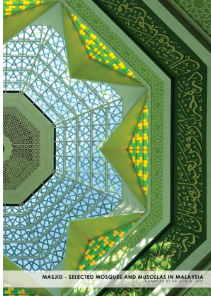
Kota Kinabalu City Mosque is the second major mosque built in the city of Kota Kinabalu in Sabah , Malaysia after the State Mosque. The mosque was officially opened on 18 February 2000 following the declaration of Kota Kinabalu as a city . This mosque has the characteristics of the Prophet’s Mosque with almost 70 percent of the mosque area surrounded by water.
The architectural design is based on the Nabawi Mosque, the second holiest site in Islam, in Medina, Saudi Arabia. The dome is blue and gold. The mosque is noted for its sturdy structure with a high pointed dome and four identical slender minarets. Its impressive beauty is often captured in reflections on the surface of the man-made lagoon, particularly during dawn or dusk, thus earning the name of ‘the floating mosque’ amongst the locals. It also depicts the neighbouring Kampung Air enclave of Likas Bay. The construction began in 1983, when it was first coined by the then Chief Minister of Sabah. It was only completed in 2000, following many obstacles and issues faced during the construction period, which lasted some 17 years. The mosque now houses the main prayer hall, female prayer gallery, inner courtyard, library, three madrasas. An ancillary block for staff quarters and a few amenity rooms, including a preventive care clinic and ATM machines. Arranged in a linear layout, the main prayer hall is identified with the main dome that sits on modified squinches. A series of high clerestory windows and side-tucked windows give the additional appearance of the blue-checkered dome with geometrical patterns. The dome is proportionately flanked by four round minarets of the square base with three tiers vaulted balconies and surmounted with round domes.
Many windows incorporated into the design help to provide natural lighting throughout the main prayer hall. It is also preceded by the use of an inner courtyard, which has been covered and used as an overspill prayer area. Four main round columns support the main dome squinch, fronting the qibla wall with high stained-glass windows placed high above. The mihrab is placed under the stained glass windows, with the use of green granite tiles and a square frame with Islamic calligraphic inscriptions. A smaller mihrab niche with a pointed arch is centrally placed with an Imam’s prayer spot. To the far right, an elevated minbar is built with a hanging timber roof platform.
Disclaimer : Mopsqpedia is a non-profit database. All images featured in the database are sourced from various references, publications, and websites related to mosque architecture. Mosqpedia does not claim ownership of any images unless explicitly stated. Images are provided solely for educational and bibliographic purposes. Mosqpedia disclaims any responsibility for copyright infringements related to the images displayed. Users are responsible for verifying copyright status and obtaining permission from original sources if they intend to reproduce, distribute, or use any image beyond fair use.
I agree to the terms outlined below:
You agree to upload and assign Mosqpedia Database the rights to use the content worldwide and in perpetuity across all current and future media platforms. Mosqpedia Database may edit, copy, adapt and translate your contribution.
The content will be distributed under the Creative Commons Attribution-Deed – Attribution-NonCommercial-NoDerivatives 4.0 International – Creative Commons
All data will be stored in line with data protection regulations.
I agree to the terms outlined below:
You agree to upload and assign Mosqpedia Database the rights to use the content worldwide and in perpetuity across all current and future media platforms. Mosqpedia Database may edit, copy, adapt and translate your contribution.
The content will be distributed under the Creative Commons Attribution-Deed – Attribution-NonCommercial-NoDerivatives 4.0 International – Creative Commons
All data will be stored in line with data protection regulations.